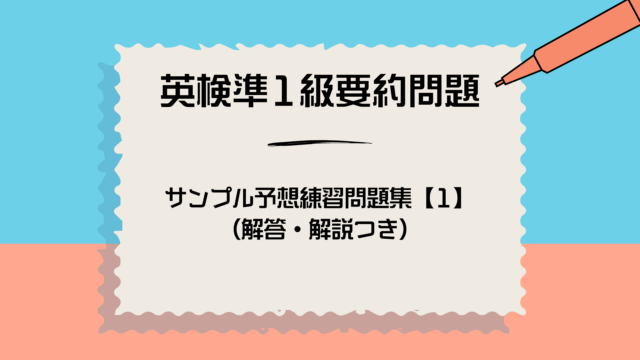
💥 衝撃の事実:英検1級要約は「パターン」が決まっていた!
英検協会の過去問を解析した結果、驚愕の事実が判明しました。
英検1級の要約問題は、必ず「問題提起→課題分析→解決策提示」の3段階構造で出題されているのです。
この構造さえ理解すれば、どんな難しいトピックでも機械的に満点が取れます。
📊 【超重要】英検1級の「3段階構造」
🎯 1級特有の文章パターン
| 段落 | 役割 | 具体的内容 | 見つけるべきポイント |
|---|---|---|---|
| 第1段落 | 🟦 問題提起 | 現状説明・新しい技術や制度の紹介 | 「何が話題になっているのか?」 |
| 第2段落 | 🟥 課題分析 | 問題点・リスク・批判的な視点 | 「何が問題なのか?」 |
| 第3段落 | 🟩 解決策提示 | 対策・バランスの取れた結論 | 「どう解決すべきか?」 |
🎯 準1級との決定的な違い
| 項目 | 準1級 | 1級 |
|---|---|---|
| 文章の複雑さ | 時系列で分かりやすい | 抽象的で多面的 |
| 求められる思考 | 論理的整理 | 批判的分析 |
| 語彙レベル | 高校~大学レベル | 学術論文レベル |
| 語数 | 60-70語 | 90-110語 |
⚡ 【実践的】1級要約「5ステップ攻略法」
Step 1: 3段階構造の特定(3分)
各段落を読みながら、以下を特定します:
- 第1段落: 「何について書かれているか?」
- 第2段落: 「何が問題視されているか?」
- 第3段落: 「どんな解決策が提案されているか?」
Step 2: キーワード抽出(3分)
各段落から2-3個ずつ、合計6-9個のキーワードを抜き出します。
【実例:都市化問題の過去問】
- 第1段落:urban growth, rural to urban migration
- 第2段落:housing shortage, infrastructure strain
- 第3段落:land reclamation, expensive solutions
Step 3: 高度な言い換え(3分)
キーワードを1級レベルの語彙に言い換えます。
【言い換え例】
- urban growth → urbanization trends
- housing shortage → residential deficits
- expensive solutions → costly interventions
Step 4: 3段階テンプレート構築(8分)
後述の「3段階テンプレート」にキーワードを当てはめます。
Step 5: 語数調整と完成(3分)
90-110語に調整して完成させます。
🏆 【実用的】3段階テンプレート
🔥 基本テンプレート
💎 上級テンプレート
🚀 最上級テンプレート
🎮 【超実践】予想問題で腕試し!
🔥 1級レベル予想問題:「AI教師の導入と教育の未来」
問題文
Educational institutions worldwide are increasingly adopting artificial intelligence to enhance learning experiences. AI-powered teaching systems can provide personalized instruction, adapt to individual learning styles, and offer 24/7 availability. These systems promise to address teacher shortages while delivering consistent, high-quality education to students regardless of their geographical location or socioeconomic background.
However, the integration of AI in education raises significant concerns. Critics argue that human interaction is irreplaceable in developing students’ emotional intelligence and social skills. Additionally, there are worries about data privacy, as AI systems collect vast amounts of personal information about students’ learning patterns and behaviors. The digital divide also means that students without access to advanced technology may be further disadvantaged.
To maximize benefits while minimizing risks, educators propose a hybrid approach. This involves using AI to handle routine tasks like grading and basic instruction, while preserving human teachers for complex problem-solving, creative thinking, and emotional support. Strict data protection regulations and efforts to ensure equitable access to technology are also essential components of this balanced strategy.
🏆 満点解答例(テンプレート別)
解答例1(基本テンプレート)
The article discusses the widespread adoption of AI-powered teaching systems in educational institutions worldwide, highlighting their significant potential to provide personalized instruction and effectively address growing teacher shortages. However, this technological development presents several serious challenges, including major concerns about reduced human interaction, critical data privacy issues, and the persistent digital divide affecting disadvantaged students. To address these complex issues, the author suggests implementing a comprehensive hybrid approach that strategically combines AI for routine administrative tasks with human teachers for complex instruction, emphasizing the urgent need for strict data protection regulations and equitable technology access to ensure sustainable educational outcomes. (100 words)
解答例2(上級テンプレート)
The text examines the comprehensive integration of artificial intelligence in education, highlighting its significant potential benefits for personalized learning and addressing teacher shortages globally. Nevertheless, significant concerns arise, particularly regarding the loss of human interaction essential for emotional development and serious data privacy risks from extensive student information collection. Consequently, experts recommend adopting a hybrid educational model, which requires combining AI technology for routine instructional tasks with human educators for complex problem-solving and emotional support, while implementing comprehensive data protection measures and ensuring equitable technological access to achieve sustainable educational transformation and innovation. (93 words)
解答例3(最上級テンプレート)
While AI-powered educational systems offer promising opportunities for personalized learning and addressing global teacher shortages, their implementation reveals complex pedagogical and ethical challenges. The primary concerns include the potential erosion of human interaction crucial for students’ emotional and social development, and significant data privacy risks from comprehensive behavioral monitoring, which threaten educational equity and student welfare. Therefore, the article advocates for a carefully balanced hybrid approach, involving strategic integration of AI for administrative and basic instructional functions while preserving human educators for complex cognitive and emotional guidance, coupled with robust regulatory frameworks to ensure both technological accessibility and comprehensive data protection across diverse educational contexts. (105 words)
🎯 【必須】C1レベル語彙変換テクニック
💫 具体→抽象の変換表
| 具体的表現 | 基本変換 | 1級レベル変換 |
|---|---|---|
| AI teachers | artificial intelligence in education | automated pedagogical systems |
| teacher shortage | lack of educators | educational personnel deficits |
| data privacy | information protection | data security protocols |
| digital divide | technology gap | technological disparities |
| hybrid approach | combined method | integrated pedagogical framework |
🔥 1級必須の接続表現
| 機能 | 基本レベル | 1級レベル |
|---|---|---|
| 対比 | however | nevertheless / conversely |
| 結果 | so | consequently / therefore |
| 追加 | also | furthermore / additionally |
| 譲歩 | although | while / despite |
| 強調 | very important | crucial / essential |
🚀 【重要】1級受験者が陥る「5つの落とし穴」
❌ 落とし穴1: 具体例に固執する
悪い例: In London, the congestion charge was introduced in 2003…
良い例: Urban authorities implemented traffic pricing mechanisms…
❌ 落とし穴2: 準1級レベルの語彙で満足する
1級では、より高度で専門的な語彙が求められます。
❌ 落とし穴3: 文章構造を無視する
3段階構造を理解せずに書くと、論理的一貫性が失われます。
❌ 落とし穴4: 語数管理を怠る
90語未満または110語超過は大幅減点の対象です。
❌ 落とし穴5: 自分の意見を混入させる
要約は原文の内容のみを扱い、個人的な見解は含めません。
🎉 【特典】1級レベル「表現の武器庫」
🌟 問題提起を表現するフレーズ
- The article addresses the growing trend of…
- Recent developments in X have led to…
- The text examines the implications of…
🔄 課題分析を導入するフレーズ
- However, this approach raises several concerns…
- Nevertheless, significant challenges emerge…
- Despite these advantages, critics point out…
⚖️ 解決策を示すフレーズ
- To address these issues, experts recommend…
- The article proposes a balanced approach involving…
- Therefore, a comprehensive strategy is needed…
📝 【結論】英検1級要約は「構造理解」が全てだった!
英検1級の要約問題は、確かに難しいですが、明確なパターンがあります。
- 3段階構造(問題提起→課題分析→解決策提示)を理解する
- 高度な語彙変換で1級レベルの表現力を身につける
- 実践的テンプレートで確実に論理的な文章を構築する
- 時間管理で20分以内に完成させる
この4つのスキルをマスターすれば、英検1級要約問題で確実に高得点が取れます。
もう難しい文章に怯える必要はありません。構造を見抜く力で、英検最高峰を制覇してください!




